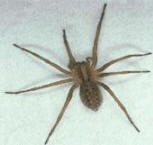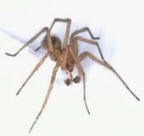
Female Hobo Spider

Male Hobo Spider
Male: 8-11mm
(size of the body excluding legs)
- The female hobo spider stays in her web; so, the male searches for
here. He jerks and taps at the funnel web’s entrance in a specific
pattern that alternates with advances and retreats. The female may
attack and kill the female if the signals are not clear. If the female
is responsive, the male slowly adds silk to web of the female and
gradually approaches the female. The male leaves and search for other
females after mating.
- The female produces one to four egg cases; Each case holds 50-100 eggs. The female attaches the egg cases underneath objects, normally outdoors. The egg sac always consists of soil or other unusual matter between the two layers of silk. The female usually dies in their web after they have constructed their egg sacs and deposited them in sheltered areas.
- Headaches, nausea, vomiting, soreness, and flue-like symptoms.
- In the cases were the bite has not been attended in the early stage, skin graft, amputation, and the possibility of bone marrow failure can occur.
- When venom is injected, the victim will experience an immediate
redness which develops around the bite then begins to disappear after
few hours. For the first 24 hours, the bite appears to be worse; then it
begins to blister in the centre. The blister breaks open within 24 to 36
hours, living an open, oozing ulceration.
- A permanent scar is left within three weeks from the initial bite. If the bite is delivered in fatty tissue, the lesion may be very deep and extensive, not healing for over two or three years.
The female transfers the seminal fluid into the female by expanding the sinuses in his palp. Once the sperm is inside the female, she stores it in a chamber and only uses it during the egg laying process, when eggs come into contact with the sperm for the first time and are fertilized.
Indoors, keep beds 6 inches or more from walls and adjust bedding so that it does not touch the floor.
Avoid storing clothes, bedding, shoes and other such items on or near floor level where hobo spiders could get entangled or trapped in them. As stated previously, most hobo spiders are found in basements or ground level floors, so the above measures apply mostly to these areas.
Chemical control with insecticides can be used. Since the
idea is to kill spiders when they come indoors, a residual insecticide should be used to provide a lasting effect.
Insecticide formulations that are applied dry and those that form a suspension (rather than a solution or emulsion) are more effective against spiders because the active ingredient tends to remain on the treated surface rather than soak into it.
Measures to eliminate suitable habitat for the hobo spider can be implemented both indoors and outdoors. Indoors, clean frequently behind furniture, under baseboard heaters or radiators, in closets, and in other undisturbed areas. Use a vacuum cleaner to remove spiders and their webs, and then place the dust bag in the freezer in a sealable plastic bag, and dispose of it after a few hours of freezing. Remove and destroy any egg sacs that are found.
Outdoors, large cracks, crevices, or other cavities in rock walls, foundations, or other constructions should be filled in with mortar or cement. Long grass around the foundations of houses, garages, or storage sheds should be kept trimmed or eliminated. Wood piles and other stacked materials or items should be placed to eliminate the spaces between items as much as possible. Yard debris, such as old boards or other large objects on the ground surface should be removed.
Exclusion measures include sealing holes where pipes enter the house, sealing cracks or crevices in the foundation, installing seals around doors that have large gaps, and repairing broken screens or windows that may provide a path of entry.